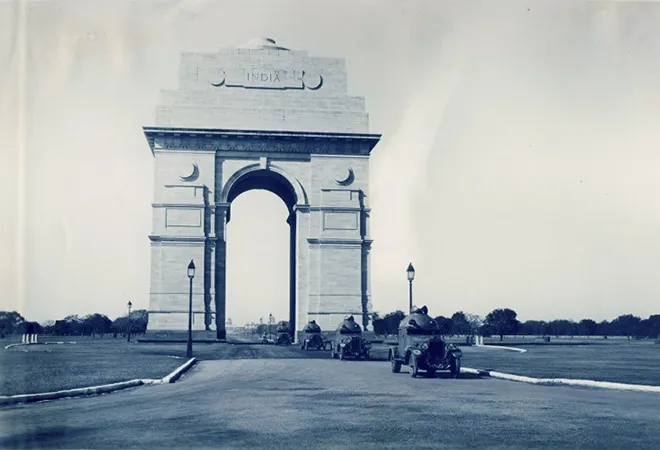Just east of India Gate –where, under the arch, an everlasting flame flickers in remembrance of martyrs – is an empty canopy built along with the rest of colonial New Delhi in the 1930s. This once housed a statue of George V – King of England when the shifting of the capital from Calcutta to New Delhi was announced in 1911 at the third Durbar with the monarch present in Delhi.
The 1960s drive to substitute colonial memories with homages to nationalist, Indian leaders, put paid to old George V balefully eyeing the Viceregal Lodge -now Rashtrapati Bhawan- through the arch of India Gate and the vista between the two secretariat structures on Raisina Hill. George V was shifted to a less glamorous location and thereby forgotten in transactional New India.
However, no government since then could figure out whom or what should replace the erstwhile monarch under the canopy. Fittingly it remains empty. Should something be out there – absolutely not! Here are three reasons why not.
First, monuments are steeped in symbolism. The fact that the Imperial canopy lies empty reinforces that the Union Jack no longer flies on what was the Viceregal Lodge. Once the Raj evaporated, in theory, power has passed onto the people of India, who rule themselves. There is no longer a need to promote allegiance amongst the public to a monarchy, which rather cannily sought, through adoption of Indian regal attributes like Durbars, ceremony and pomp, to buy into the heritage of previous rulers of Delhi – the Mughals and others before them, since the 12th century AD. Swapna Liddle’s “Connaught Place and the making of New Delhi” is an enchanting short read (Speaking Tiger 2018) which is full of such nuggets from History for New Delhi aficionados.
Second, the empty canopy is an eloquent statement that in a democracy, power and official status, are transient. The institutional positions remain constant. But the faces change fairly frequently – often once every year when coalitions are unstable. Of the fourteen Indian Prime Ministers, seven had tenures of less than two years, versus five years being a full term.
The empty space under the canopy is thus not a vacuum. Instead, it is a loaded reminder of impermanence to the high and might, even as they come and bow their heads in salute at the martyrs’ memorial every year.
Third, the canopy could be occupied by an installation representing the people of India – as is common in Soviet style architecture. There is one such installation at the trisection of Willingdon crescent – now named after Mother Theresa – and Sardar Patel Marg at the western edge of the grounds of the Rashtrapati Bhawan. It looks nice but appears out of context to its surroundings.
Immediately facing it is the exclusive residential zone of Chanakyapuri. Behind it is the Rashtrapati Bhawan, which, if anything, is a constant reminder that the Indian State, willingly and unapologetically stepped into the comfortable accoutrements of our colonial masters, complete, with exclusive housing estates which effectively extern all but foreign diplomats, the politically significant or the very rich, in separate complexes and the house-help, which serve these elites.
In contrast, the Dandi march was Bapu’s way of using peaceful disobedience to enlarge the freedom movement, beyond the exclusive enclaves of the professional classes by associating the common people with breaking the unjust colonial law, which imposed tax on production of salt, without representation – akin to the Boston Tea Party in the United States.
Situating the sculpture at the epicentre of public and private high privilege appears inappropriate; a mite touristy because the AC tourist buses conveniently glide along the carriageway offering it as a “heritage piece of the National Movement” and finally unthinking, because it languishes forlorn on a broad avenue where no one walks and everyone drives.
The big fear is that, were the government to try and fill in the empty space under the canopy, what would emerge could be similarly out of context and possibly, either inelegant, if it did not match the colonial surroundings or worse, merely slavishly copycat, as were the palaces of the India Princes which came up around Princes Park or more recently, Maharashtra Sadan, next to Baroda House.
If one cannot either afford good art or if one doesn’t have the inclination to spend the time and empathy required for great sculpture, it is best to leave a place unadorned by anything but nature.
Finally, leaving well alone would also be a pithy statement on the biggest political economy conundrum facing India and the world today – to which the answer is yet to be found. Where does the balance lie along the continuum between the vicissitudes of direct democracy at one end, as exemplified by BREXIT and the potentially constraining, long-term impact of any form of Totalitarianism on innovation, reduction of inequality, protection of freedom and human dignity? In much the same way and a bit more practically, where lies the balance between the power of crony capitalism, at one end of the continuum, to deliver state led development on undreamt of massive scale, as in China and the long, hard slog of developing markets, competition, private enterprise and equitable but light touch regulation, as we are attempting in India?
There are more questions than answers. Possibly the empty space under the canopy should be reserved for the one who finds the sweet spot and sticks around long enough to actualise the public gains thereof. No need to rush through though. There is plenty of time.
This commentary originally appeared in The Times of India.
The views expressed above belong to the author(s). ORF research and analyses now available on Telegram! Click here to access our curated content — blogs, longforms and interviews.




 PREV
PREV


